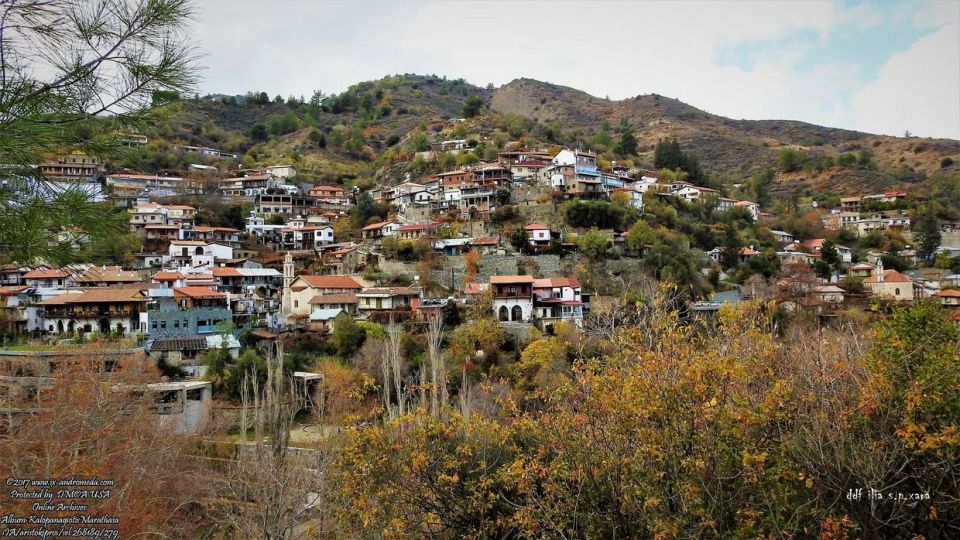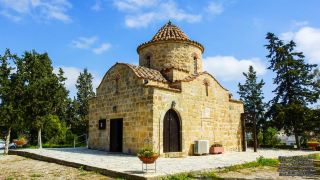Kalopanayiotis village is found on the shores of Setrachos river on an altitude of about 700 metres. The houses that make up the settlement, “rise” onto the western side, with an intense slope on the valley of Marathasa, in the depth of which the river flows.
The village does not have a lot of history, since its first resident arrived in the area during the 11th century. However, this location was known not only in Cyprus but also in neighbouring countries for tis thermal springs from the very olden years.
On the eastern shore of the river, very close to its bed, there were and still are many springs gushing out of huge rocks. These springs are thermal and they were exploited by the leaders of the Solon Kingdom, founding the “Asclepieio” in honour of their God, Asclepios.
Its glamor and greatness are still visible today, even though there are only basins carved in the rock, which were used by the priests of the Church for their patients’ treatment.
A few metres north from the thermal springs, there was a building complex with rooms for the patients’ accommodation. All of the above was destroyed and looted after Christianity was in power in Cyprus.
The buildings of the Asclepieio were demolished and a Church and Monastery were built in their place, in honour of Agios Heracledios. During the years that followed, next to the initial Church, another one was built in honour of Agios Ioannis Lambadistis. A lot later, next to the two Churches, another one was built. The 3 Churches look like one externally.
Like in all Cypriot monasteries, the Monastery of Agios Ioannis Lambadistis was visited by many people, who mainly dealt with the agricultural works of the monastery. The first person inhabiting the area was someone called Panayiotis.
In a short amount of time, six settlements were built around the monastery, and each one had its own authorities and its own Church. As time went by, with the prevalence of the settlement built by Panayiotis, after he conquered the others, the six settlements were joined and became one, which was called “Oikismos tou Panayioti” (Panayioti’s Settlement).
The name “Kalopanayiotis” refers to the first time, during the British rule, after a paraphrase of the Franc name of the “settlement of Panayiotis” which was pronounced in Cypriot as “Kazalopanayiotis”.
For the name of the village, there is another version referring to three brothers who each built a village. However, these are stories for small children and are not worth being told.
What has Kalopanayiotis to offer its Cypriot and foreign visitors as a village and location?
The location in which the village is built, in a narrow valley surrounded by high, intense, green slopes, is so harmonically and beautifully combined with the houses’ architecture, that the village actually “disappears” from the observer’s eye into the green.
The Setrachos river is accessible at many points and offers you unique and amazing images with the Venetian bridges in the first plan. The platanus, alder and other hydrophilic trees and bushes create riverside forests, heaven for many singing birds.
The monastery, and the great number of churches will remind you of the village’s history and you will need many hours to study them. A few dozens of metres away from the Monastery, you will find the church of Panagia Theoskepasti. A beautiful chapel on the riverside of Setrachos, which every visitor of the village should visit.
The always overflowing dam of Kalopanayiotis, apart from its usefulness for irrigating great areas of agricultural land along the length of the Valley of Marathasa, it also “matches” beautifully with the general image that you will get from its dyke, since you can see until Moutoullas from there.
All of the above would have no value at all if the people of Kalopanayiotis were not as they are. These people are welcome and kindhearted, ready to help you and answer to all of your questions having to do with their village.
Kalopanayiotis is a destination that can and has the possibility to offer a lot to its visitors.




